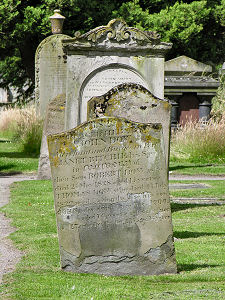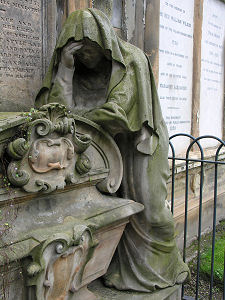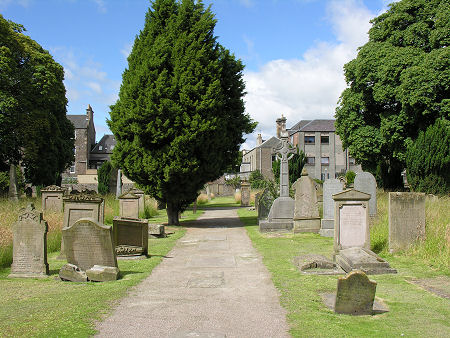 Greyfriars Burial Ground |
In the south-east quadrant of central Perth lies the Greyfriars Burial Ground. Lying south of Canal Street and west of Tay Street this fascinating graveyard contains one of the best collections of old gravestones to be found anywhere in Scotland.
Greyfriars became a burial ground in 1580 when the kirkyard of St John's Kirk ran out of space. The site chosen had a long religious tradition. A Franciscan friary was founded here in 1496, on a site just outside the boundary of the medieval burgh of Perth. The friary was destroyed at the start of the Reformation in the rioting that following a sermon given by John Knox. on 11 May 1559 in the nearby St John's Kirk of Perth: and this presented an ideal opportunity when a new burial ground was needed.
Burials began immediately, and the earliest surviving gravestone dates back to the year in which the burial ground opened, 1580. There would probably be more very early stones surviving had gravestones from Greyfriars not been among the building materials seized when Cromwell's troops built a citadel on South Inch in 1652.
Greyfriars Burial Ground was extended to the south to provide more space in 1795, and again in 1820. Paths were laid in what had until then been a fairly chaotic space in 1835, and decorative planting undertaken. Burials continued here until 1978, but Greyfriars was largely replaced when Westhill Cemetery was opened in 1849. Between 1999 and 2001 Greyfriars was restored by Perth & Kinross Council.
Today's Greyfriars is accessible via its north gate, from the car park in Canal Street, or via the east gate created in 2001 to allow access from Tay Street. Like many urban cemeteries, Greyfriars can become a gathering place for those with nothing else to do, and there are times when visitors might find it more comfortable not exploring on their own.
A sign attached to wall beside the Tay Street entrance tells visitors that the burial ground is being managed as a "biodiversity bank", in which wildflowers, butterflies and insects are encouraged to flourish: and that it will be cut at the end of the summer after the flowers have seeded. This is laudable, but the practical effect is that for much of the summer, when most visitors are likely to visit the burial ground to view the gravestones, most of them are partly or completely concealed by very long grass. Only a broad fringe alongside each of the paths running through the burial ground is kept mown, and exploration beyond the mown fringe is a fairly adventurous undertaking. Despite this, the gravestones that do remain on view are still worth travelling out of your way to see.
Greyfriars is rectangular in shape, and rather longer from north to south than it is from east to west. The main path runs north-south down the centre of the burial ground, dividing it into eastern and western halves. And a series of cross paths, some paved and some of mown grass, subdivide each of the halves.
Much of the joy of exploring somewhere like this is in the exploration itself. And the great thing about Greyfriars is that wherever you go and wherever you look, there are interesting and worthwhile gravestones and monuments to see. Greyfriars is especially strong in the variety of stones bearing symbols of mortality and of the trades of the individuals interred, dating back to the 1700s.
It is also a treasure house of monuments dating back to the first half of the 1800s. The most striking of these on artistic, if not necessarily taste, grounds is to be found against the east wall of Greyfriars. This is the monument erected by his congregation in memory of the Reverend Samuel George Kennedy, who died on 30 December 1835. The monument comprises a life size statue of a weeping lady in a gown leaning on a highly elaborate sarcophagus, which oddly, looks only large enough to accommodate a child. The slab carrying the text remembering the Rev Kennedy is set into the wall above the sarcophagus. The overall effect is remarkable, if a little creepy.
Whatever else you do at Greyfriars, do not miss the 13 stones moved under the shelter of a roof erected at the south end of the burial ground in 2001. These form one of the best groups of early gravestones you are likely to see anywhere in Scotland. They include the Buchan Stone from 1580 and two others dating back to the 1600s. But the real stars are the highly decorated carved stones from the 1700s, some of which are shown on the right.
The image above right shows an "Adam & Eve Stone" dating from 1782 and representing the biblical story of the Garden of Eden. The exquisite ship carving is on a stone erected in memory of Cirsten Biset, spouse of a sailor (presumably a wealthy one). The horse and cart is found on the gravestone commemorating several generations of the Peter family, who worked as carriers. The stone shown bottom right commemorates William Clement, a dyer who died in 1788. The stone illustrates tools of his trade, including a press, napping shears and a glove.
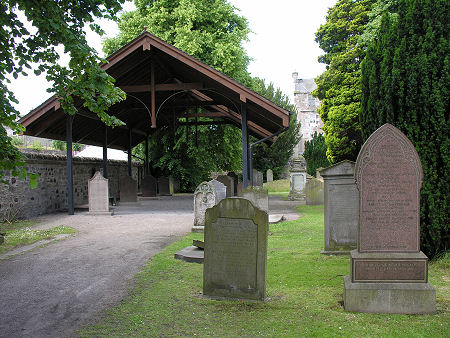 Shelter for the Most Interesting Stones at the South End |

|
|
|
Visitor InformationView Location on MapGrid Ref: NO 120 233 What3Words Location: ///leaps.maple.foods |
 1782 Adam & Eve Stone,
and Others 1782 Adam & Eve Stone,
and Others |
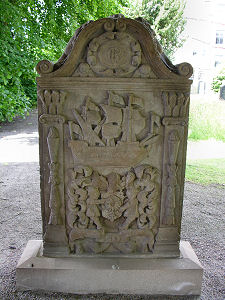 Ship on Cirsten Biset's
1747 Stone Ship on Cirsten Biset's
1747 Stone |
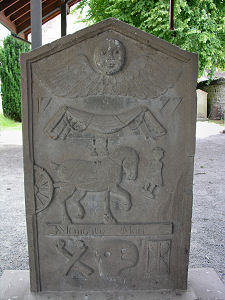 Horse &
Cart on Carrier's 1753 Stone Horse &
Cart on Carrier's 1753 Stone |
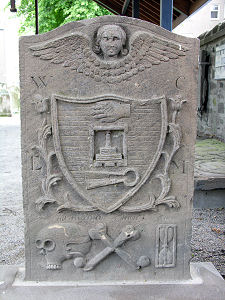 William Clement, Dyer, 1788 |
